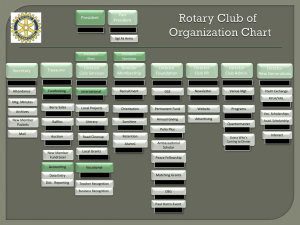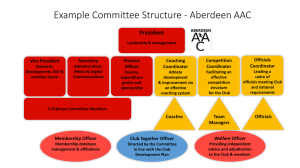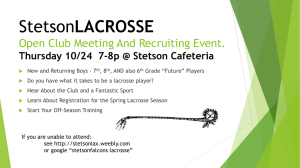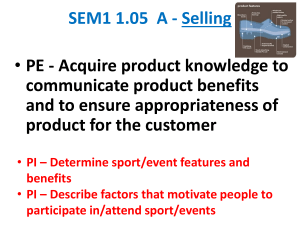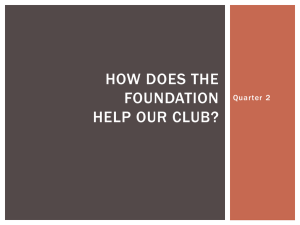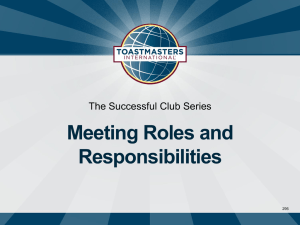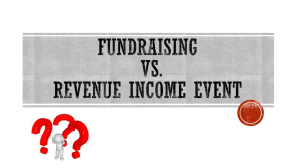Motivational Factors for Student Participation in
advertisement
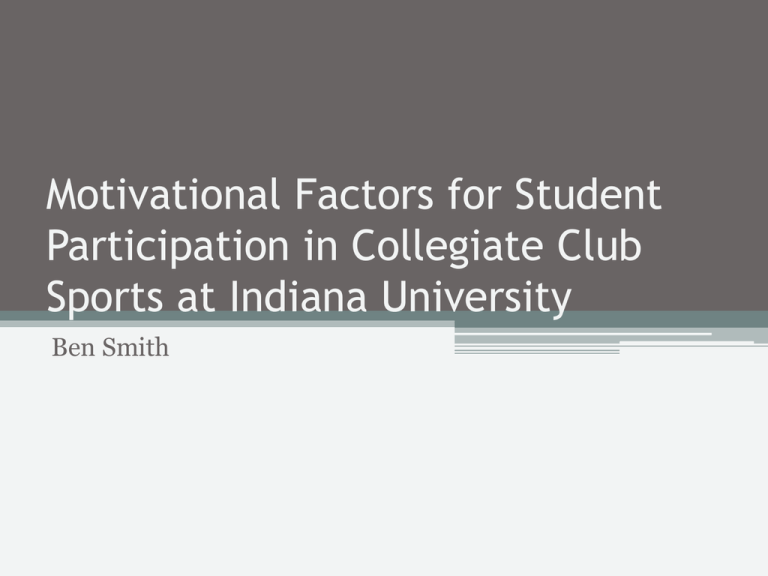
Motivational Factors for Student Participation in Collegiate Club Sports at Indiana University Ben Smith Collegiate Club Sports • Indiana University’s Division of Recreational Sports (2007) define a club sport as a ▫ “group of individuals who meet regularly to pursue an interest in a particular sport activity. The organization of the club may be structured or casual. Each club is developed, governed, and administered by the student membership of that particular club” Introduction • Club vs. Other Recreational Sport Programs • Motivation vs. Benefit Based Outcomes • Exploratory study to establish reliability of instrument Research Statement • Examine motivational factors among participants in collegiate club sports at Indiana University during the 2007-2008 school year. • Why only club members? Purpose and Justification of Study • Build upon limited research on collegiate club sports • Help campus recreational sport professionals better cater to the needs of club participants • Shed light on how club sports are an important component in students’ college experience • Aid in future developments of campus club sport operations Selection of Subjects • All registered club sport students at Indiana University during the 2007-2008 school year (approximately 1,400 members in 44 club sports) • Faculty, staff, and community members were also used in this study Data Collection • Permission from the Director of Club Sports in the Division of Recreational Sports at Indiana University to contact members via email • Presented the study briefly to Club Sport Federation • Set of emails that include a link to an online questionnaire • Surveymonkey Measuring Motivations • Leisure Motivation Scale (Beard & Ragheb, 1983) ▫ Psychological and sociological reasons for participating in leisure activities. ▫ 4 sub-areas measured: Intellectual Social Competence-mastery Stimulus-avoidance • Highest score = primary motivational factor • Lowest score = factors they may avoid when participating • 5 point Likert Scale Sub-Areas • Intellectual ▫ Learning, using logic, strategizing, creating • Social ▫ Meaningful relationships (friendships), esteem of others • Competence-mastery ▫ Need to compete, master skills, challenge, status level • Stimulus-avoidance ▫ Seek mental and physical relaxation, escape factors of daily life Leisure Motivation Scale Club Sports • One of my reasons for participating in my club sport is… • • • • • __ 1. __ 2. __ 3. __ 4. __ 5. __ 6. to expand my interests to seek stimulation to make my college experience more meaningful for me to learn about things around me to satisfy my curiosity to explore my knowledge • • • • • • __ 7. to learn about myself __ 8. to expand my knowledge __ 9. to discover new things __ 10. to be creative __ 11. to be original __ 12. to use my imagination • • • • • • __ 13. to be with others __ 14. to build friendships with others __ 15. to interact with others __ 16. to develop close friendships __ 17. to meet new and different people __ 18. to help others • • • • • • __ 19. so others will think well of me for doing it __ 20. to reveal my thoughts, feelings, or physical skills to others __ 21. to influence others __ 22. to be socially competent and skillful __ 23. to gain a feeling of belonging __ 24. to gain other’s respect • • • • • • • • • • • • • • • • • • • • __ 25. to obtain feeling of achievement __ 26. to see what my abilities are __ 27. to challenge my abilities __ 28. because I enjoy mastering things __ 29. to be good at the sport __ 30. to improve skill and ability in the sport • • • • • • __ 43. to avoid the hustle and bustle of daily activities __ 44. to refresh, re-create __ 45. to relieve stress and tension __ 46. to do something simple and easy __ 47. to unstructure my time __ 48. to get away from the responsibilities of my everyday life __ 31. to compete against others __ 32. to be active __ 33. to develop physical skills and abilities __ 34. to keep in shape physically __ 35. to use my physical abilities __ 36. to develop my physical fitness __ 37. to be in a calm atmosphere __ 38. to get away from my regular routine __ 39. to escape and get a change of pace __ 40. to seek solitude __ 41. to relax physically __ 42. to relax mentally Hypotheses • Subjects participating in club sports have motivational factors that will not differ depending on various demographics (e.g. gender, class standing, number of years participating, etc.). • Subjects will not report intellectually motivating factors for participating in club sports. • Subjects will not report socially motivating factors for participating in club sports. • Subjects will not report competence-mastery motivating factors for participating in club sports. • Subjects will not report stimulus-avoidance motivating factors for participating in club sports. Response • 1,366 club sport participants were contacted ▫ 282 went beyond study information sheet ▫ 229 completed 80.6% of the study ▫ 18.6% of all participants completed survey enough to analyze motivational factors ▫ Not all provided responses to every statement Response • 7 of 44 clubs did not have at least 1 person participate in study • Highest response rate = Swim Club (N=30) • Men’s Lacrosse (N=15) • Taekwondo (N=13) • Men’s Ultimate Frisbee (N=12) • Equestrian (N=12) • Ballroom Dance (N=12) • 2-3/week 42.6% (N=98) • 4-5/week 32.2% (N = 74) • 74.8% participate more than twice a week Class Standing and Gender Class Standing • Freshmen • Sophomore • Junior • Senior • Graduate • Faculty/Staff • Community Member • Total Frequency 96 47 48 28 39 8 3 269 ▫ Males: 57.1% (N=128) Females: 42.9% (N=96) Percent 22.8 21.0 21.4 12.5 17.4 3.6 1.3 100.0 Data Analysis • Descriptive statistics – trends • ANOVA – compared means among demographic items (class standing and gender) • Tukey’s HSD – pinpointed where the significance lay specifically Hypothesis Testing • Each of the 5 hypotheses were rejected as significance was found either among class standing, gender, or both. Number of Statements with Significance Found Hypothesis Class Standing Gender H1 Yes Yes H2 5 1 H3 9 7 H4 6 0 H5 0 7 Intellectual Motivation and Class Standing • 5 significant statements among 7 class standings ▫ 7 with ANOVA, 5 after more rigorous Tukey’s HSD ▫ All significance =Undergraduate v. Graduate Students S1. To expand my interest S3. To make my college experiences more meaningful for me S9. To discover new things S10. To be creative S11. To be original Significance • Graduate students have already been through the college experience • Undergraduates focused on getting the most out of their time in college – well rounded • Graduate students may only participate in the sports they already are familiar with • Low creativity factor = Graduate students not concerned with creativity. More focus on studies Social Motivations and Class Standing • 9 significant statements • Undergraduate v. Graduate (17 instances) Faculty/Staff (3 instances) ▫ ▫ ▫ ▫ ▫ ▫ ▫ ▫ ▫ S13. To be with others S16. To develop close relationships S17. To meet new and different people S18. To help others S20. To reveal my thoughts, feelings, or physical skills to others S21. To influence others S22. To be socially competent and skillful S23. To gain a feeling of belonging S24. To gain others respects Significance • Sub-area with most significant statements • “To be with others” = Graduate low score compared to undergrad but higher than all intellectual statements. • “Relationships” = priority during first years in college – Graduate students have different focus • “New and different people” = Small importance for Faculty/Staff – always new poeple Significance • “Belonging” and “Influence” (Juniors v. Grad) = more office positions once a team veteran What benefits are gained? 89.2% (N=199/223) “socializing” 88.8% (N=198/223) “meeting new people” Competence-Mastery and Class Standing • 6 significant statements • Highest overall means of sub-areas ▫ ▫ ▫ ▫ ▫ ▫ To obtain feeling of achievement (M=4.104, SD.945) To Challenge what my abilities are (M=4.484, SD .724) To be good at the sport (M=4.365, SD .886) To compete against others (M=3.659, SD 1.312) To keep in shape physically (M=4.608, SD .764) To use my physical abilities (M=4.52, SD .81) Competence-Mastery and Class Standing Between Groups Number of Significant Statements Freshman v. Graduate Students Sophomore v. Graduate Students Junior v. Graduate Students Freshman v. Faculty/Staff Sophomore v. Faculty/Staff Junior v. Faculty/Staff Sophomore v. Community Members Freshman v. Community Members 5 4 5 1 1 1 1 1 Trends • “To compete against others” = lowest score for all class standings. ▫ Drop from Freshman – Community Member ▫ As classes mature, less motivated to prove their abilities (“obtaining achievement”, “good at sport”) • “Develop physical abilities” = no significance ▫ All classes above 4.0 (often true) Stimulus-Avoidance •No statements with significance and Class Standing •Lowest overall mean score of sub-area (M=2.52) •Trends • “To seek solitude” = lowest score in all classes but CM • “Calm atmosphere”, “relax physically”, “simple and easy” all reported as “seldom true” • “Relieve stress and tension” highest overall mean in this sub-area Intellectual Motivation and Gender • 1 significant statement ▫ S10. To be Creative (F=4.275, p<.05) • Higher overall scores reported by females for all statements = More motivated by intellectual components • Both gender reported above 4.29 ▫ S2. To seek Stimulation ▫ S3. To make my college experience more meaningful for me Social Motivation and Gender • 7 of 12 statements with significance • “be with others”, “build friendships”, “interact with others” ▫ Females tend to be more social. Connect with others Males participate for reasons related to self Females participate for wider variety of reasons • Open ended question Liked most? Social motivations Competence-Mastery and Gender • No Significance • Males reported higher overall mean than Females • “Skill Development” = 3rd response behind social motivations • Only chance to play at higher competition level • Sports not offered at varsity level at IU: ▫ ▫ ▫ ▫ Men’s Lacrosse Men’s Waterpolo Ice Hockey Men’s Volleyball Stimulus-Avoidance and Gender • 7 of 12 significant statements • Relation to Intellectual Motivations for Females ▫ Relax and escape academic pressures • Similar trends for both ▫ Not alone ▫ Challenging and organized ▫ Stress reduction Findings • Competence-Mastery: Highest motivation for participation (M = 4.40) ▫ Not necessarily competition (only statement below 4.0) Important but not main focus ▫ Improving person skill, training opportunities ▫ Being active in sport • Stimulus-Avoidance: Not a motivator (M = 3.19) ▫ Opposite - higher social responses (M = 3.60) Considerations • • • • Skill training sessions Regular active practices Challenging drills/sets (pushing limits) Social environments among club time and beyond • Women more motivated by intellect challenges and gaining knowledge through sport • Beard, J. G., & Ragheb, M. G. (1983). The leisure motivation scale. Journal of Leisure Research, 15 (3), 219-228.
